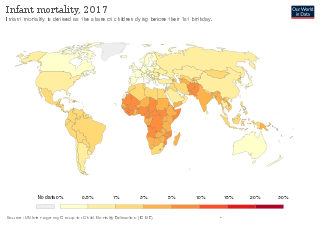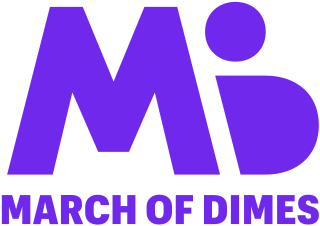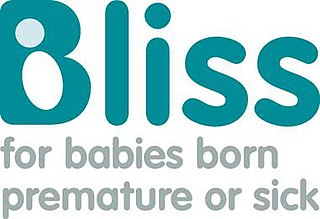
Infant mortality is the death of an infant before the infant's first birthday. The occurrence of infant mortality in a population can be described by the infant mortality rate (IMR), which is the number of deaths of infants under one year of age per 1,000 live births. Similarly, the child mortality rate, also known as the under-five mortality rate, compares the death rate of children up to the age of five.

Childbirth, also known as labour, parturition and delivery, is the completion of pregnancy where one or more babies exits the internal environment of the mother via vaginal delivery or caesarean section. In 2019, there were about 140.11 million human births globally. In the developed countries, most deliveries occur in hospitals, while in the developing countries most are home births.

Preterm birth, also known as premature birth, is the birth of a baby at fewer than 37 weeks gestational age, as opposed to full-term delivery at approximately 40 weeks. Extreme preterm is less than 28 weeks, very early preterm birth is between 28 and 32 weeks, early preterm birth occurs between 32 and 34 weeks, late preterm birth is between 34 and 36 weeks' gestation. These babies are also known as premature babies or colloquially preemies or premmies. Symptoms of preterm labor include uterine contractions which occur more often than every ten minutes and/or the leaking of fluid from the vagina before 37 weeks. Premature infants are at greater risk for cerebral palsy, delays in development, hearing problems and problems with their vision. The earlier a baby is born, the greater these risks will be.

March of Dimes is a United States nonprofit organization that works to improve the health of mothers and babies. The organization was founded by President Franklin D. Roosevelt in 1938, as the National Foundation for Infantile Paralysis, to combat polio. The name "March of Dimes" was coined by Eddie Cantor. After funding Jonas Salk's polio vaccine, the organization expanded its focus to the prevention of birth defects and infant mortality. In 2005, as preterm birth emerged as the leading cause of death for children worldwide, research and prevention of premature birth became the organization's primary focus.

Kangaroo mother care (KMC), which involves skin-to-skin contact (SSC), is an intervention to care for premature or low birth weight (LBW) infants. The technique and intervention is the recommended evidence-based care for LBW infants by the World Health Organization (WHO) since 2003.

A neonatal intensive care unit (NICU), also known as an intensive care nursery (ICN), is an intensive care unit (ICU) specializing in the care of ill or premature newborn infants. The NICU is divided into several areas, including a critical care area for babies who require close monitoring and intervention, an intermediate care area for infants who are stable but still require specialized care, and a step down unit where babies who are ready to leave the hospital can receive additional care before being discharged.
Fetal viability is the ability of a human fetus to survive outside the uterus. Medical viability is generally considered to be between 23 and 24 weeks gestational age. Viability depends upon factors such as birth weight, gestational age, and the availability of advanced medical care. In low-income countries, half of newborns born at or below 32 weeks gestational age died due to a lack of medical access; in high-income countries, the vast majority of newborns born above 24 weeks gestational age survive.

Birth weight is the body weight of a baby at its birth. The average birth weight in babies of European and African descent is 3.5 kilograms (7.7 lb), with the normative range between 2.5 and 4.0 kilograms. On average, babies of Asian descent weigh about 3.25 kilograms (7.2 lb). The prevalence of low birth weight has changed over time. Trends show a slight decrease from 7.9% (1970) to 6.8% (1980), then a slight increase to 8.3% (2006), to the current levels of 8.2% (2016). The prevalence of low birth weights has trended slightly upward from 2012 to the present.
The Canadian Perinatal Network (CPN) is made up of Canadian researchers who collaborate on research issues relating to perinatal care. The network commenced in September 2005, and includes members from 25 tertiary perinatal units. CPN will enable health care professionals, researchers, and administrators to participate actively in clinical, epidemiologic, health services, health policy, and informatics research aimed at improving the effectiveness and efficiency of perinatal care.
Early postnatal hospital discharge generally refers to the postpartum hospital discharge of the mother and newborn within 48 hours. The duration of what is considered "early discharge" varies between countries from 12 to 72 hours due to the differences in average duration of hospital stay. The World Health Organisation (WHO) recommends healthy mothers and newborns following an uncomplicated vaginal delivery at a health facility to stay and receive care at the facility for at least 24 hours after delivery. This recommendation is based on findings which suggest that the first 24 hours after giving birth poses the greatest risks for both the mother and newborn.

Bliss is a UK-based charity for infants. Bliss supports the families of babies in neonatal care and works with health professionals to provide training and improve care for babies. It campaigns for improved hospital resources across England, Scotland, Wales and Northern Ireland, and is actively involved in neonatal research.
Childbirth in rural Appalachia has long been a subject of concern amongst the population because infant mortality rates are higher in Appalachia than in other parts of the United States. Additionally, poor health in utero, at birth, and in childhood can contribute to poor health throughout life. The region's low income, geographic isolation, and low levels of educational attainment reduce both access to and utilization of modern medical care. Traditional medical practices, including lay midwifery, persisted longer in Appalachia than in other U.S. regions.
This article summarizes healthcare in Texas. In 2022, the United Healthcare Foundation ranked Texas as the 38th healthiest state in the United States. Obesity, excessive drinking, maternal mortality, infant mortality, vaccinations, mental health, and limited access to healthcare are among the major public health issues facing Texas.
Neelam Kler is an Indian neonatologist, known for her pioneering work on neonatal intensive care and ventilation. She is credited with developing neonatal care to better the survival rate of extremely tiny preterm babies to 90 per cent. The Government of India honoured her with the third-highest civilian award, Padmabhushan, in 2014, for her services to the fields of medicine and neonatology.
Nils Bergman, is a Swedish specialist in perinatal neuroscience and a promoter of skin-to-skin contact between a mother and newborn.
Tiffany Martini Field is professor in the departments of pediatrics, psychology, and psychiatry at the University of Miami School of Medicine and director of the Touch Research Institute. She specializes in infant development, especially with regard to the impact of maternal postpartum depression on mother-infant interaction and the efficacy of massage and touch therapy in promoting growth and emotional well-being in premature and low birth weight infants.
The weathering hypothesis was proposed to account for early health deterioration as a result of cumulative exposure to experiences of social, economic and political adversity. It is well documented that minority groups and marginalized communities suffer from poorer health outcomes. This may be due to a multitude of stressors including prejudice, social alienation, institutional bias, political oppression, economic exclusion and racial discrimination. The weathering hypothesis proposes that the cumulative burden of these stressors as individuals age is "weathering," and the increased weathering experienced by minority groups compared to others can account for differences in health outcomes. In recent years, the biological plausibility of the weathering hypothesis has been investigated in studies evaluating the physiological effects of social, environmental and political stressors among marginalized communities. This has led to more widespread use of the weathering hypothesis as a framework for explaining health disparities on the basis of differential exposure to racially based stressors. Researchers have also identified patterns connecting weathering to biological phenomena associated with stress and aging, such as allostatic load, epigenetics, telomere shortening, and accelerated brain aging.

Joy Elizabeth Lawn is a British paediatrician and professor of maternal, reproductive and child health. She is Director of the London School of Hygiene & Tropical Medicine Maternal, Adolescent, Reproductive & Child Health (MARCH) Centre. She developed the epidemiological evidence for the worldwide policy and programming that looks to reduce neonatal deaths and stillbirths and works on large-scale implementation research.
Jasmine Y. Zapata is an American physician and epidemiologist. She is the chief medical officer and state epidemiologist for community health at Wisconsin Department of Health Services. Her career includes work as a pediatrician, public health researcher, assistant professor at the University of Wisconsin, author, and her support for youth empowerment with a variety of initiatives.
Louise Clare Kenny is a British physician who is Professor and Executive Pro-Vice-Chancellor at the University of Liverpool. She was elected an Commander of the Order of the British Empire in the 2022 New Year Honours.









